
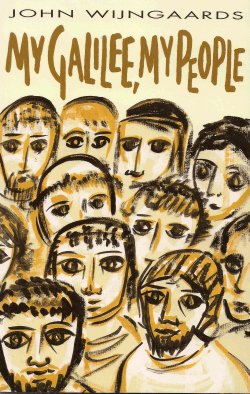 I would like to take you, in a flight of imagination, to a village in
the country side of Galilee. We enter a small hamlet, Cana. The year is 28 AD.
'We are going to watch a miracle', you think. Yes, we are; but it is not for
making you taste water changed into wine that I am taking you with me. I want
you to look at the scene with new eyes.
I would like to take you, in a flight of imagination, to a village in
the country side of Galilee. We enter a small hamlet, Cana. The year is 28 AD.
'We are going to watch a miracle', you think. Yes, we are; but it is not for
making you taste water changed into wine that I am taking you with me. I want
you to look at the scene with new eyes.
Jesus is standing on the dusty road between mud-walled houses. He has a small band of disciples with him, fishermen from Capernaum. Like the other wedding guests they have put on new clothes. (1) Mary, Jesus' mother who is also there, and other women, are holding oil lamps in their hands. (2) The sun is going down. The groom has gone to fetch the bride from her parents' home. We hear elated shouts. The procession has begun!
Jesus, who, we may assume, is related to the bride, shares everyone's excitement. There she comes, wearing a colourful gown, a crown of lace on her head, her face covered with a veil. People play on pipes and drums. There is singing and dancing to the music. The procession stops. The bride's father takes the veil from the girl's face and lays it on the shoulder of the bridegroom, saying: 'The government shall be upon his shoulder'. (3) Bride and groom look at each other. People clap and cheer. Jesus too smiles at the bride and the groom when they catch his eye.
What goes through his mind? We can be sure he is not thinking at this moment of the legal formality that sealed the marriage earlier that day. At that time the two families signed the written contract, the ketuba, that spells out the financial security the bride will receive in case of a divorce. Jesus does not agree with divorce. He abhors the ease with which some scribes condone it. 'What God has joined, no one should pull apart'. But at this moment he is not thinking of divorce. Like all the other wedding guests, he allows himself to be transformed by pure joy, the joy of these two people he knows, their happiness in finding each other and starting a new family.
The procession arrives at the new house which the groom's family have prepared for the young couple. There is no room inside for the whole wedding party. A clearing nearby, a thresh- ing floor perhaps, has been turned into an open air festival hall. The catering is done in kitchens and backyards of relatives and neighbours. Bride and bridegroom enter under the chuppa, a canopy decorated with garlands and flowers. Bride and groom exchange vows. They drink of the same cup of wine. Seven blessings are spoken over them.
'Praise be to you, Lord our God, king of the universe! ....
You have created joy and happiness,
bridegroom and bride,
rejoicing, song, pleasure and delight,
love and belonging,
peace and friendship ....
Praise be to you who give happiness to the bridegroom and the bride!(5)
Jesus' heart flows over with joy. When Jesus, later that night or perhaps during the next day, changes water into wine, we may easily be carried away by the religious implications of this sign. Of course, the Eucharist is foreshadowed here - something nobody present understood at the time. The Old Testament i Law, symbolised by the six jars 'meant for ritual washing, (6) gives way to the new covenant, the banquet to which all nations of the world will be invited. (7) But these wider implications of the sign should not overshadow its immediate intent.
For Jesus is saying something about his people. Peasants who eat and drink deserve no headlines in this world's press. Nor can a shortage of wine after many generous helpings rank as a major disaster. Yet, his mother's simple words 'They have no wine', provoke an unheard of response. In effect Jesus provides another 600 litres of wine (8) to the feasting farmers. It means the continuation of the party; more dancing, more joy.
So often we focus on the sign in a one-sided way. We idolise the new wine ('You've kept the best wine until now!'), and dream of renewal, resurrection, spiritual transformation. But we overlook the other side of the coin, the reality that is changed. That is: we forget about the water. Without the limestone water of Cana, the earthenware jars, the kitchen boys, the blustering 'best man', the embarrassed groom and the revelling farmers, the sign means nothing.
In this book we will try to see the Gospel in a new light; from the other side, as it were, from Jesus' own experience as a Galilean. We shall see that the Gospel presupposes life rooted in everyday people and things.
To understand Jesus and his message we have to know the world to which he belonged. We have to know his people. None of us live in isolation. Neither did Jesus. Like us he imbibed his cultural outlook and his way of speaking and thinking from his family. Like us, Jesus became the person he was by responding to the pressures and challenges of society around him. Since he was a first-century Galilean, we cannot fully grasp his personality and his uniqueness without an appreciation of what Galilean society was like.
But that is not all. Jesus' devotion to his homeland conveys a message of its own. For devoted he was. Even though he occasionally moved out into other territories such as Phoenicia, the Decapolis, Samaria or Judea, he always remembered his special mission to Galilee.
'Land of Zebulun!
Land of Naphtali!
Way of the sea, far shore of the Jordan,
Galilee of the nations!
Your people, who live in darkness, will see a great light.' Matthew 4,14-16 (9)
Yes, he died in Jerusalem. But after his resurrection he returned to Galilee. The women at the tomb were told: 'Tell the disciples: 'He has been raised from the dead. He's no longer here (in the tomb). He's going to Galilee ahead of you. There you will see him!'. (10)
There is much we can learn from studying Jesus' background. It will explain traits of his character. It will put many of his words in perspective. It will throw a new light on the Incarna- tion itself: if God wanted to become visible in one of us - 'Who sees me, sees the Father'(11) - , why did he choose a God-forsaken place like Galilee? '
Study the Scriptures and you will see that no prophet ever came from Galilee!' John 7,52
The power of God's mysterious dealings with us overwhelms us; all the more so the more we discover the human limitations of Jesus. Of course, we should have known. God's Incarnation is real incarnation, that is: The Word God speaks to us became human flesh and took on the limitations of our human living. (12)
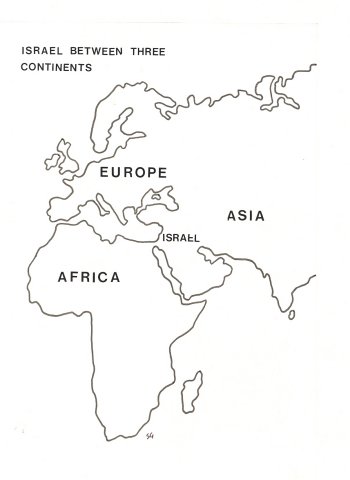
The 'land of the Jews', the country 'flowing with milk and honey' which in Old Testament times became the property of Israel, lay in between three continents: Africa to the South, Europe to the North, Asia to the East. On its western flank the land bordered the Mediterranean Sea.
Jesus lived in Galilee, two thousand years ago. At that time Galilee was a province of a country known by the Romans as 'the land of the Jews'. It makes sense to look at the whole country first; and for this we need to turn to a world map. There, in the part of the world we call the 'Middle East' today, we find its location: it covered roughly present-day Israel and Jordan.
Because of its central position it possessed valuable land and sea routes for international trade. It was the frequent scene of wars. All the great powers of the ancient world: Egypt, Hatti, Assyria, Babylon, Persia, Greece and Rome, occupied it at some time or other.
In the course of history it carried many names. The Assyrians called it Mat Palastu, 'hill country of the Philistines'; because of the Philistine settlements on the coast. The Greeks used the expression Palestine Syria, from which the English name 'Palestine' derives. The ancient Egyptians knew it as Canaan, a name we still find in the Bible. (13) Other biblical names were: the land of Israel(14) and the Holy Land (15). This last name is still popular among Christians who consider it the 'Holy Land' mainly because Jesus lived there.
In Jesus' time, Palestine was divided into many provinces. Three of these provinces had a predominantly Jewish population: JUDEA, PEREA and GALILEE (see the map below). The inhabitants of SAMARIA were the promiscuous offspring of Jews and Assyria immigrants. The IDUMEANS and NABATEANS in the South were Arabs. The people of the DECAPOLIS and the other Transjordan regions belonged to a mixed race with a hard core of Greek colonists. PHOENICIA in the North was inhabited by Tyrians, Sidonians and Syrians. Palestine was a true melting-pot of nations.
Luke, the evangelist, purposely fixes the beginning of Jesus' public ministry within a wider scale than Galilee, both in space and time.
It was the fifteenth year of Emperor Tiberius.
Pontius Pilate was governor of Judea.
Herod was tetrarch of Galilee.
His brother Philip was tetrarch of Iturea and Trachonitis.
Lysanias was tetrarch in Abilene.
Annas and Caiaphas were high-priests .... Luke 3,1-2
History provides more details:
Tiberius was Roman Emperor from 14 to 37 AD.
His fifteenth year was 27/28 AD.
Pilate was the Roman governor of Judea, Samaria and Idumea from 26 to 36 AD.
Herod Antipas was tetrarch (king) of Galilee and Perea from 4 to 39 AD.
Philip ruled his kingdom from 4 to 34 AD.
Caiaphas was high priest in Jerusalem from 18 to 36 AD. His father-in-law, Annas, was head of the priestly family.
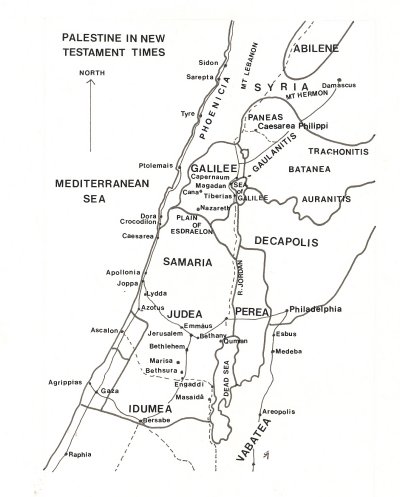
Luke presents Jesus' ministry within a wider historical setting, because he wants to underline Jesus' universal mission: 'all humankind will see God's salvation!'.(16) Is this to offset his earlier report: that God had sent Gabriel 'to a town in Galilee named Nazareth'? (17) After all, Galilee was a region of underdogs and nobody had ever heard of Nazareth! The tension between Jesus' humble origins and his meaning for the whole world is there for all to see.
The centre of the Jewish religion and Jewish power lay in Judea; in Jerusalem, in fact. The most flourishing 'modern' cities belonged to the Decapolis. Where did that leave Galilee?
We can now have a closer look at Galilee itself. The main features of the province were its hills and mountains (see the relief map below). The hills of Lower Galilee (around Nazareth) were not as high and rugged as those of Upper Galilee (around Safed and Gischala). Mount Meron in the north and Mount Tabor in the south stand out. Galilee possessed two plains: the Valley of Esdraelon on its southern border and the plain of Genesareth on the shore of the lake.
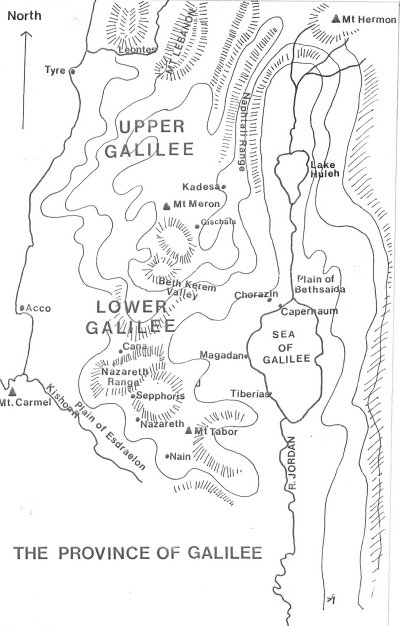
The name 'Galilee' is quite old; it may ante-date Israelite occupation.(17) It means 'circle' or 'region'. In the Hebrew Old Testament it occurs six times. (18) Isaiah gives the full name Galilee of the nations, which for Jews meant 'Galilee of the pagans'; the Greek book of Maccabees quotes the name with that meaning.(19) The name may well reflect the experience of the inhabitants of the hill country: that they were surrounded by other nations, pagans that is, on all sides.
Because of the valleys and low-lying lands on all its borders Galilee was vulnerable. Armies coming from the North or the South had easy access. They could march either along the shore, 'the way of the sea’ (21), or along the Jordan valley.
Galilee in Jesus' time had three different kinds of towns and villages:
* larger, Greek-style towns; these were Sephphoris and Tiberias;
* smaller Jewish townships; among them we find Jotapata, Gischala, Capernaum and Corozain;
* hamlets and villages; Nazareth and Nain belonged to this category.
Jesus' Galilee was neither big nor famous. As long as people could remember, it had been a backwater, both in politics and religion. No illustrious kings had ruled here. No national prophet had been born on its soil. It possessed no monument of a great past. It was not even an independent country; it always was subservient to one power or an other.
For more than seven long centuries Galileans had been under foreign overlords. It is hard to imagine the impact this must have had on the native population. Always foreign soldiers on your soil who need to be billeted and fed; foreign officials who demand labour and a share of the crop; a foreign judge in court; foreign governors who import their own people and give them estates on your ancestral land. As a result, always being underdogs in your own country.
It had begun in 734 BC when the Assyrian king Tiglathpileser III captured Galilee. He deported many people to Assyria. (22) Historians believe these were the Jewish leaders and their families. The farmers and village folk were left behind, to provide the annual taxes. (23)
Assyrians ruled, Babylonians took over, then the Persians after them. Four hundred years with just one change of colonial officials after an other descending on Galilee. The Jewish exiles who returned home under King Cyrus of Persia, (24) seem to have settled mainly in Jerusalem and Judea. For the hill country of Galilee still had its rural Jewish population.
When Alexander the Great defeated the Persians and conquered Syria in 332 BC, the era of the Greeks began. Galilee, like the rest of Palestine, became subject to them. First the Ptolemaids predominated; they ruled from Alexandria in Egypt. Then the Seleucids who were resident in Antioch, got the upper hand. It was under these kings that the Greeks tried to impose their own religion on the Jews. A religious persecution was unleashed (167 - 164 BC) which also affected Galilee. It led to the Maccabean revolt.
|
The foreign masters of Galilee 734 -539 BC. Assyrians, then Babylonians.Galilee part of the Assyrian (later Babylonian) province of Megiddo. 539 -333 BC. Persians. Galilee part of the fifth Persian satrapy, 'Eber-ha-Nahar'. 333 -120 BC. Greeks. From 312 to 218 BC, Galilee a 'hyparchy' under Alexandria in Egypt. From 218 to 120 BC, Galilee part of the 'eparchy' of Samaria, under Antioch in Syria. 120 -63 BC. Hasmoneans. Galilee a province administrated from Jerusalem. 63 BC - 70 AD (and later). ROMANS. From 47 BC to 4 AD, Galilee part of the kingdom of the Idumean Herod the Great. From 4 - 39 AD, Galilee part of the 'tetrarchy' of Herod's son, Herod Antipas. |
Simon the Maccabee invaded Galilee in 164 BC and took some Jews back with him to Judea. (25) Historians say these were Jews living on the coast. (26) Again, the farmer population of lower and upper Galilee were left to their own devices. A period of intense confusion followed with civil war between Greek armies ravaging Galilee.
The Hasmonean John Hyrcanus liberated Galilee forty years later. Another sixty years of civil war followed, this time between Jewish factions. The Hasmoneans who were descended from the Maccabees, had made themselves high priests as well as kings. Therefore they were not accepted by traditional religious groupings such as the Pharisees.
Then the Romans entered the scene in 63 BC under General Pompey. In Jesus' time it was they who occupied the country, even if they partly exercised their power through middlemen such as Herod Antipas, Philip and Lysanias.
The influence of these foreign rulers had left their mark on Galilee. Each colonial power had imposed a network of its own officialdom: army officers, tax collectors, rural governors and traders who gradually became part of the population, especially in the main centres of government. Succeeding administrations introduced new languages. The foreign immigrants brought with them new artifacts and skills which the local people were made to copy. All this led to the emergence of a very cosmopolitan society in the trade centres of the Galilean plains.
In the villages and small townships of the hill country, however, the original inhabitants tried to guard their Jewish origins. Although they had frequent contacts with the people in the plains, they sought to retain their own distinctiveness. Fear of the occupying armed forces, resistance to the foreign tax collectors, indignation at attempts to erode their faith and similar conflicts could not but harden their will to protect their identity.
With this new historical insight, we should, I believe, look at the wedding scene again. The first thing we notice is how Jewish the celebration is. Certainly, there are things that remind us of Galilee's cosmopolitan neighbours. The jars in the compound and the cups on the table carry a Cypriot design. The bride's dress had been dyed in a Phoenician workshop; perhaps in Tyre or Sidon. The master of the feast, the architriklinos (27), fulfils a role copied from hellenistic banquets. But the heart of the wedding, the main rituals, its philosophy, the cultural and religious values it enshrines, are a hundred per cent Jewish. It fills us with admiration for these simple country folk who kept their precious traditions intact in spite of so many eroding influences.
Secondly, we understand better now the almost fanatical love these people bore towards their own country. We cherish a possession all the more if we are in danger of losing it. The Galileans loved their land, their religious heritage, that tiny part of the world that was their own. Jesus was one of them. He, too, loved his Galilee.
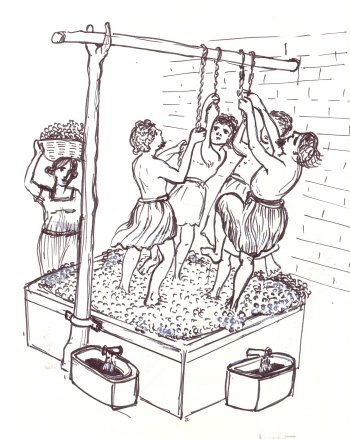
Treading the grapes was a joyful activity at the end of the harvest.
'The days are coming when harvest will follow ploughing, the treading of grapes the sowing.
Then the mountains will run with new wine. All the hills will flow with it' (Amos 9,13).
Jesus' love for his country was too rich and too deep to exclude other people in a narrow-minded nationalism, as we will see in the following chapters. His love for Galilee was nonetheless real. We cannot truly love the world at large and all people universally, if we do not begin by loving our own part of the world and its inhabitants in a special way. The Telugus in India have an interesting song which expresses a deep human reality.
'Of all villages in the land my own village is dearest to me.
Of all streets in my village my own street is dearest to me.
Of all homes in my street my own home is dearest to me.'
Unless we are anchored in our own home, our own street, our own village and our own country, we cannot reach out to other people and understand how they too have their Galilee, which paradoxically, is as dear to them as our own is to us. Every person's Galilee is unique. Jesus' 'kingdom of heaven' does not float in the air; it rests on every individual, human piece of soil. The new wine he presents is not created out of nothing; it is a transformation of the plain water found in the kitchens of everyday life.
And that is only the beginning of the mystery of Galilee.
1. Jesus loved Galilee and Galileans. Others did not. They looked down on Galilee.
'Study the Scriptures and you will see that no prophet ever came from Galilee!' (Read John 7,52).
What are the implications of this fact for you?
2. In all four Gospels we are told Jesus returned to Galilee after his resurrection.
'He is going to Galilee ahead of you. There you will see him!' (Read Matthew 28,7; Mark 16,6-7; Luke 24,6; John 21,1-14).
Was it important for Jesus to visit Galilee once more? Why?
3. Comment on this passage of Vatican II in the light of your realisation that Jesus was a Galilean:
He who is 'the image of the invisible God' (Colossians 1,15) is himself the perfect human being .... By his incarnation the Son of God has united himself in some way with every human person. He worked with human hands. He thought with a human mind. He acted with a human will and loved with a human heart. Born of the Virgin Mary he has truly been made one of us, like us in all things except sin.' The Church in the Modem World, no 22.
| 1. Matthew 22,11-13. | 2. Matthew 25,1-12. | 3. Isaiah 9,6. | 4. Mk 10,2-12. |
5. Scholars are unable to reconstruct all the details of a wedding ceremony in Jesus' days. The outline sketched here is very ancient. For a brief description and the text of the blessings, see N.MANGEL, Siddur Tehillat Hashem, Brooklyn 1982, p.410.
6. John 2,6.
7. Isaiah 25,6-8.
8. The six jars held each 'two or three metrêtês' (John 2,6). A metrêtê was equal to about 40 litres, or 9 gallons.
9. Quoted from Isaiah 8,23-9,1.
10. Matthew 28,7; Mark 16,6-7; Luke 24,6.
11. John 14,9.
12. John 1,14: 'The Word became flesh and lived among us'.
13. ‘The land Canaan': Genesis 11,13; 13,12; 16,3; etc. Also 'land of the Amorites': Joshua 24,8; Amos 2,10.
14. 'The land of Israel' for the whole country’: 1 Samuel 13,19; Ezekiel 12,19. Usually it denotes the northern kingdom.
15. 'The holy land': Zechariah 2,12; Wisdom 12,3; 2 Maccabees 1,7.
16. 1. Luke 3,6; see also Isaiah 40,5.
17. Luke 1,16.
18. A.ALT, 'Die Herkunft des Namens Galiläa', Kleine Schriften, vol.2, Munich 1959, pp. 363 - 435.
19. Joshua 20,7; 21,32; 1 Chronicles 7,76; 1 Kings 9,11; 2 Kings 15,29; and Isaiah 9,1.
20. Isaiah 9,1 and 1 Maccabees 5,15.
21. Matthew 4,15.
22. 2 Kings 15,29.
23. K.GALLING, 'Galiläa, Judäa und der Osten im Jahre 163 v.Christus', Palästina Jahrbuch 36 (1940) p. 64.
24. Ezra 8,1-14.
25. 1 Maccabees 5,23.
26. S.KLEIN, Galiläa vor der Makkabäerzeit bis 67, Berlin 1928, pp.1-5; S.FREYNE, Galilee from Alexander the Great to Hadrian, Wilmington 1980, pp.37-39.
27. The term literally means 'head of the three tables'. According to Greek custom, tables were arranged in a horseshoe for banquets. The person in charge of the feast looked after food and drink, seating arrangements, and so on. The function is alluded to in Sirach 32,1-2.